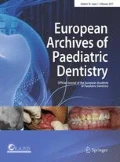Abstract
Background
An allergic reaction following a dental procedure is a rare event. A local anaesthetic (LA) may initially be suspected as a causative agent but allergy to dental LA solutions is extremely rare.
Case report
This report concerns a 13 year old child who underwent dental treatment and was exposed to Lignospan Special® LA, mouthwash, latex gloves, ibuprofen medication, and a Magnum® (almond) ice cream all within 45 min. He subsequently developed acute symptoms of nasal rhinorrhoea, facial flushing, peri-orbital and lip angioedema, followed by throat tightness and wheeze (respiratory compromise). His acute reaction was treated by his medical practitioner with oral anti-histamines, steroid and nebulised salbutamol. The child was referred to a local allergist. The child underwent detailed allergic investigations including skin prick tests, blood tests, incremental local anaesthetic challenge and ibuprofen challenge. The patient was diagnosed with NSAID exacerbated respiratory disease (NERD), a hypersensitivity reaction to ibuprofen.
Follow-up
The patient was advised to avoid NSAIDs and to wear a medic-alert (allergy) bracelet. A detailed written report was sent to the patient’s dentist and GP.
Conclusions
In the context of a suspected reaction post dental procedure, local anaesthetic should be considered a possible allergen but other important considerations include analgesics, antibiotics, and latex. All genuine allergic reactions need to be investigated. This report highlights NERD as a possible adverse outcome following dental treatment.
Similar content being viewed by others
References
Baker L, Hourihane JO. Latex allergy; two educational cases. Pediatr Allergy Immunol. 2008;19(6):477–81.
Calderon AL, Diot N, Benatir F, et al. Immediate allergic cross-reactivity to levobupivacaine and ropivacaine. Anaesthesia. 2013;68:203.
Chandler MJ, Grammer LC, Patterson R. Provocative challenge with local anesthetics in patients with a prior history of reaction. J Allergy Clin Immunol. 1987;79:883.
Chiu CY, Lin TY, Hsia SH, et al. Systemic anaphylaxis following local lidocaine administration during a dental procedure. Pediatr Emerg Care. 2004;20:178.
Conaghan PG. A turbulent decade for NSAIDS: update on current concepts of classification, epidemiology, comparative efficacy, and toxicity. Rheumatol Int. 2012;32:1491–502.
Cuesta-Herranz J, de las Heras M, Fernandez M, et al. Allergic reaction caused by local anesthetic agents belonging to the amide group. J Allergy Clin Immunol. 1997;99:427.
deShazo RD, Nelson HS. An approach to the patient with a history of local anesthetic hypersensitivity: experience with 90 patients. J Allergy Clin Immunol. 1979;63:387.
Gall H, Kaufmann R, Kalveram CM. Adverse reactions to local anesthetics: analysis of 197 cases. J Allergy Clin Immunol. 1996;97:933.
Goodman EJ, Morgan MJ, Johnson PA, et al. Cephalosporins can be given to penicillin allergic patients who do not exhibit an anaphylactic response. J Clin Anesth. 2001;13:561–4.
Haugen RN, Brown CW. Case reports: type I hypersensitivity to lidocaine. J Drugs Dermatol. 2007;6:1222.
Kowalski ML, Asero R, Bavbek S, et al. Classification and practical approach to the diagnosis and management of hypersensitivity to nonsteroidal anti inflammatory drugs. Allergy. 2013;68:1219–32.
Kowalski ML, Makowska JS, Blanca M, et al. Hypersensitivity to nonsteroidal anti-inflammatory drugs (NSAIDS)– classification, diagnosis and management: review of the EAACI/ENDA and GA2LEN/HANNA. Allergy. 2011;66:818–29.
McClimon B, Rank M, Li J. The predictive value of skin testing in the diagnosis of local anesthetic allergy. Allergy Asthma Proc. 2011;32:95–8.
Morais-Almeida M, Gaspar A, Marinho S, et al. Allergy to local anesthetics of the amide group with tolerance to procaine. Allergy. 2003;58:827.
Sambrook PJ, Smith W, Elijah J, et al. Severe adverse reactions to dental local anaesthetics: systemic reactions. Aust Dent J. 2011;56:148–53.
Sampson HA, Ho DG. Relationship between food-specific IgE concentration and the risk of positive food challenges in children and adolescents. J Allergy Clin Immunol. 1997;100(4):444–51.
Solensky R, Kahn DA. Drug allergy: an updated practise parameter. Ann Allergy Asthma Immunol. 2010;105:259–73.
Wang J. Management of the patient with multiple food allergies. Curr Allergy Asthma Rep. 2010;10(4):271–7.
Warrington RJ, McPhillips S. Allergic reaction to local anesthetic agents of the amide group. J Allergy clin Immunol. 1997;100:855.
Author information
Authors and Affiliations
Corresponding author
Ethics declarations
Funding
There was no funding received by the authors for this case report.
Conflict of interest
The authors declare that they have no conflict of interest.
Ethical approval
This case report does not contain any studies with human participants or animals performed by any of the authors.
Informed consent
Informed consent was obtained from all individual participants included in this case report.
Rights and permissions
About this article
Cite this article
King, G., Byrne, A. & Fleming, P. A case of severe NSAID exacerbated respiratory disease (NERD) following a dental procedure in a child. Eur Arch Paediatr Dent 17, 277–281 (2016). https://doi.org/10.1007/s40368-016-0233-0
Received:
Accepted:
Published:
Issue Date:
DOI: https://doi.org/10.1007/s40368-016-0233-0




